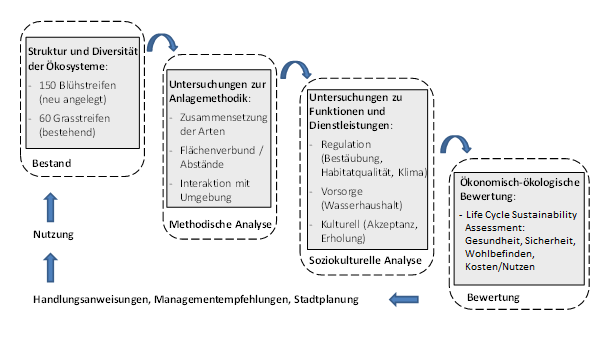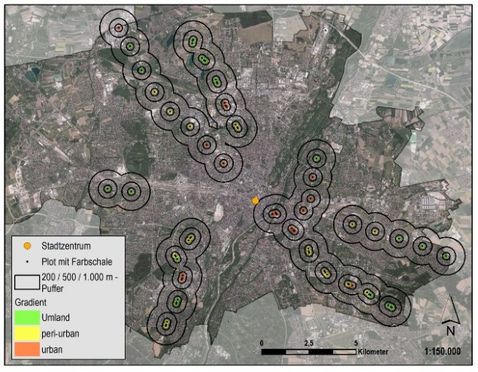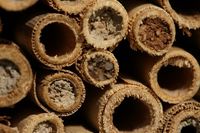Installation of Flowering Areas
The seed mixture was designed according to several selection criteria. Only autochthonous wild plants were available for selection, which are suitable both in terms of their attractiveness to insects and their ability to cope with the special soil and climate conditions in the city. The plant species were grouped according to their functional properties (Tab. 1) using a cluster analysis and selected with a view to maximising phylogenetic diversity.
Finally, 26 plants were used, mainly species of anthropo-zoogenic heaths and lawns and herbaceous vegetation of often disturbed places. The flowering areas were sown in April to May 2019 after removing the turf and applying a sowing substrate. Germination and emergence of the target species was documented in two vegetation surveys using counting squares.
In the first year of the project (2019) 23 flowering areas of 16 m² each were created. The experimental design envisages the creation of a further 75 areas at exponential distances from each other over the next three years (Fig. 1). These varying distances take into account the maximum collection distances of solitary wild bees as the most important pollinator group and serve as indicators for the analysis of the maximum distances individual flowering areas can have to each other in order to facilitate exchange and movement between urban pollinator populations as 'stepping stones' and to facilitate the recolonisation of suitable habitats.
Due to the annual expansion of the flowering area, the streets are viewed in a spatio-temporal context and the extent to which they are used as potential corridors of movement is also examined.

Landscape Analysis

The surrounding landscape and land use of a study site determines to a large extent whether and which pollinator species are found there. In order to obtain a picture of the landscape influencing factors of the city of Munich, landscape elements and land use types were mapped within a radius of 200, 500 and 1000 m around each plot (Fig.2).
This classification is based on the flight distances of different pollinator species, which can vary considerably depending on their lifestyle and body size.
Within the 200 m radius, manual mapping was carried out, in the larger radii digital data was used (Open Street Map, Corine Land Cover). Subsequently, a categorization of the plots into the urbanization degrees 'urban', 'peri-urban' and 'rural' was made on the basis of the landscape data. The degree of sealing and the percentage of green spaces and private gardens played a decisive role here.

Insect Monitoring
At all plots, a total of 132 nesting aids were installed in 2019 to study above-ground nesting solitary wild bees and wasps (Fig. 3). After colonisation, these nests can be opened and the nesting animals and their antagonists (predators and parasitoids) can be determined at genus or species level. In addition, paint trays were used to record the insect occurrence on the experimental plots in the city. The shells serve as dummies of flowers and are particularly suitable for providing insights into the widest possible range of species of flower-visiting insects. The captured insects were sorted into large groups; wild bees, bumblebees and hoverflies are identified by species.
First Conclusions
- In the total number of species as well as in the accumulation of the target species there are clear differences in the degree of urbanisation
- Compared to peri-urban and rural areas, significantly fewer species have established themselves on urban areas. This could be due to higher drought due to faster evaporation and lower water retention capacity of the compacted subsoil on urban areas. In addition, this result could also be associated with increased disturbance effects, e.g. by pedestrian footfall
- The results make it clear that in the different urban areas an adaptation of land use and management could be necessary
- The monitoring of further developments will show whether there is a possible alignment over longer periods of time
- Results of the color shell catches are presented here as an example for the group of wild bees. A total of 576 individuals from nine genera and 46 species were identified. Both abundance and species numbers of wild bees do not show any significant differences in the urbanisation categories in the data set, but a trend towards an increased occurrence of wild bees in the peri-urban area can be seen. We suspect that due to the poor habitat quality of the ecologically rather insignificant roadside greenery, wild bees appeared in the paint bowls as chance catches
- However, the effects of the proportion of green space on the abundance of wild bees at medium (500 m) and large (1000 m) scales are clearly visible. This effect can be attributed to the high proportion of 75% of ground-nesting wild bee species
- During the nesting aid experiment, 526 populated nests were examined, which contained a total of 2749 brood cells
-
The nests were used by 12 bee species from five genera, 15 wasp species from nine genera and 23 species of antagonists. On average, 18.6 % (±2.6) of brood cells were parasitized. In the statistical models, the landscape variable 'sealing' in a 500 m radius was the main factor explaining the abundance, diversity and mortality of the insects found. With increasing sealing, the models showed a decrease in abundance and species numbers as well as an increasing mortality rate. This result could indicate a shortage of food supply with increasing sealing, which means that fewer insects are present in the area and the mortality of the larvae increases due to a poorer supply of food
Summary and Outlook
According to the preliminary results, the roadside greenery has great potential as a foraging habitat, since a large number of wild bees of various genera were found, which are potential beneficiaries of these flowering areas.
The most important results:
- Pollinator abundance and diversity vary along the urban gradient
- Highest abundance and species numbers were found in the peri-urban area
- The most important factors influencing the abundance and diversity of pollinators at the landscape level are the degree of sealing and the proportion of woody plants and green areas
- Upgrading measures in roadside greenery have great potential to promote pollinators in the city
Outlook:
- Start of large-scale sowing trials with different grass percentages in Munich and at the Weihenstephan campus
- Continuation of the start of flowering area development
- Trials in the climate chambers of TUMmesa, taking into account different climate scenarios (heat, drought, atmospheric CO2 concentration)
- Continuation of data collection with paint bowls and nesting aids
- Phytometer experiment to measure the effects of flowering areas on the pollination success of selected model plants
- Preliminary experiments on release-capture-recapture experiments to study the movement behaviour of wild bees in the city
- Evaluation of the before-and-after surveys of paint trays and nesting aids